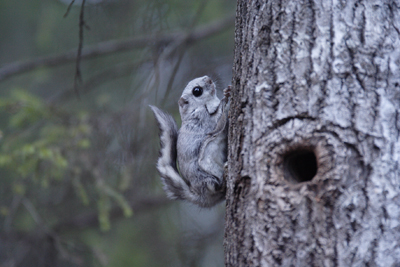The forestry sector needs to do more to ensure the future of the flying squirrel
07.01.2013 07:00 | Helsingin yliopisto |
Current instructions on retaining a few trees in clear-cut areas do not go far enough to protect the breeding or resting habitat of the flying squirrel. A recent Finnish study shows that flying squirrels abandon almost always their breeding site or resting place after clear-cutting of the forest around it.
A new Finnish study shows that current forestry instructions on leaving small wooded patches in clear-cut areas are not enough to protect the breeding of the flying squirrel. Collaboration between ecologists at the Finnish Museum of Natural History of the University of Helsinki, the University of Oulu and the University of Turku showed that flying squirrels disappear from almost all the tree cavities and nest boxes in which they live on current logging sites. In unlogged forests in the same area, the flying squirrel population remained unchanged. At logging sites, the amount of suitable habitat within a 200-meter radius dropped to about one-half of the previous amount and within a 100-meter radius to about one-third. The study was published in the internationally renowned journal Biological Conservation in January 2013.
- Statutory conservation measures have been often implemented and have achieved mixed success, but unfortunately their impact is rarely assessed, laments Senior Curator Ilpo K. Hanski of the Finnish Museum of Natural History.
- This study was carried out in the Ostrobothnia region of western Finland, but similarities between forest management and the habitat requirements of the flying squirrel mean that the results likely apply across much wider areas Hanski continues. Researchers hope that the new results will lead to a review of current logging instructions.
- My colleagues and I strive to participate more actively in the public discussion. Studies such as this one that test current practices are likely to encourage debate says Andrea Santangeli from the Finnish Museum of Natural History, a doctoral student and the lead investigator of the study. An assessment of threatened species in 2010 indicates that the Finnish population of flying squirrels is still declining. The most important reason is likely related to modern forestry practices. EU legislation guides the protection of species under the Habitats Directive. According to Finnish forestry rules from 2004 at least 0.03–0.07 hectares of habitat suitable for breeding and/or resting flying squirrels should be left in clear-cut areas. The remaining wooded patches must also be connected to a larger wooded area with an ecological corridor in which the distance between trees does not exceed their height. The flying squirrel needs an old-growth mixed forest for breeding. It usually nests in holes of large aspens, while spruce trees provide protection. The home range of the males is about 60 hectares, whereas the females move in an area of only eight hectares. The flying squirrel can also use boxes if available in suitable habitats.
Further information: Senior Curator Ilpo K. Hanski Finnish Museum of Natural History Tel. (09) 191 28853 ilpo.hanski@helsinki.fi
